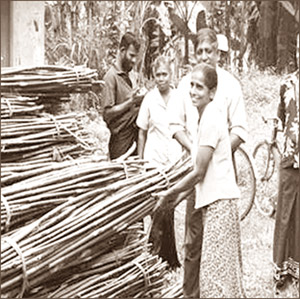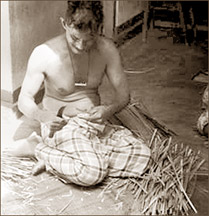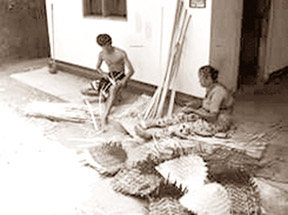The story of bamboo craft
Rukmal Salgado
A UNDP project funded by the ‘Small Grants Project’ of the ‘Global
Environment Facility’ (SGP/GEF)
|

Bamboo distributed among the villagers at the Collection Centre.
|
The bamboo (Ochlandra Stridula) craft industry is part and parcel of
the social fabric of the villages of Batuwita, Kimangoda, Batuwitta
Janasaviya, Kahagala South and Urapola in the Matara district. The
bamboo industry is a traditional family industry in the area implemented
at grassroot level. These forest dependent villagers lead relatively
isolated lives and practise indigenous customs unique to their rural way
of life.
Despite the seemingly peaceful, picturesque and idyllic rural
scenario interwoven around the 200 year old craft industry, one cannot
ignore the threats posed by the traditional bamboo craft industry to the
Masmulla forest.
Biodiversity of the Masmulla forest (about 863 hectares) in the
Matara district is threatened by the traditional craft industry.
Bamboo (Ochlandra stridula) and Innipetta (Cyathocalyx zeylanica) the
essential raw material for the craft, are obtained from the forest to
produce winowing fans, boxes, baskets and flower trays. Regular felling
of bamboo trees and other plants from the forest has pose a threat to
its biodiversity.
Other factors are encroachment, over exploitation of forest
resources, illegal timber felling, chena cultivation and the rising
population. The villagers are dependant on the forest for sustenance and
economic survival. Due to the gradual depletion of natural resources in
the forest, the only source of income of the villagers is threatened.
The ‘Small Grant project’ of the ‘Global Environment Facility’ (SGP/GEF)
of UNDP has taken a pioneering initiative to preserve and protect the
biodiversity of the Masmulla forest. In an effort to arrest further
destruction to the Masmulla forest, the Wanasarana Thurulatha Society,
carried out activities such as cultivation of ‘inipetta’, promotion of
sustainable use of non-timber forest products, watershed protection and
protection of endemic flora species.
The project has made significant contribution to environmental and
biodiversity conservation, in addition to strengthening the rural
community life through participatory forest management creating a link
with villagers.
|

The bamboo industry is a traditional family industry in the area
|
The ‘Wanasarana Thurulatha Voluntary Society’ of Matara has
introduced some durable and sustainable solutions to arrest forest
destruction. For an instance a legal permit system for bamboo felling
was successfully implemented. Villagers now obtain the bamboo plants in
a systematic manner on permits, and with the supervision of forest
officers to minimize environmental damage.
Another initiative of the project to conserve the biodiversity of
forest is the planting of a fence of 5,000 ‘Kithul’ (Caryota urens) and
‘arecanut’ (Areca catachou) saplings along the boundary to control
encroachment. In addition, over 5,000 endemic plant species (Garcinia
Quaesita, Palaquia spp., Zeylanica, Mimosoups Eleingii, Mangifera) were
planted, under the guidance of the Forest Department. The plant
nurseries are maintained by the villagers. Villagers have formed
vigilante committees to investigate and report forest offences and to
assist Forest Officers to initiate action.
Secretary of the ‘Wanasarana Society’ Piyatissa explained the
benefits of alternative income generating activities introduced by the
project. The home garden development has resulted in improved
livelihoods options and better living standards for the rural community.
Villagers are encouraged to find alternate livelihoods and refrain from
timber felling and other destructive forest offences.
The gender focus is a prominent and positive feature in the
traditional craft industry. About 90 percent of the products are woven
by women. Modern varieties of craft products are introduced through
skill development workshops and capacity building initiatives.
Finished craft products are displayed at exhibitions in cities and
provinces and sold at sale centres across the country, even in the
Northern and Eastern Provinces.
|

Villagers engaged in making bamboo craft |
Several measures have been implemented for the qualitative and
quantitative improvement of bamboo products. The provision of four wood
working machines to community centres has significantly improved the
qualitative component of the finished craft products that now fetch a
higher market price. The involvement of youth in the industry is
consciously targeted to ensure continuous interest in the industry.
The project has emphasized capacity building and skill development of
villagers to bring in new products to suit the modern market and needs.
The local demand for traditional domestic craft has increased, resulting
in a 30 percent increase in the production from 2006.
Selected villagers received skills training. Consequently, the
villagers have introduced new designs and colour scheme which now adorn
the traditional craft products. New products were introduced to cater to
the needs of the tourist industry. Lamp shades and vases sold to hotels
in the area.
Piyatissa, said he has concerns over the sustainability of industry,
despite the qualitative and quantitative improvement of crafts.
However, he is pleased that the influx of cheap plastic items are
posing a lesser threat to bamboo craft, as natural, environment-friendly
products are gaining popularity in the domestic markets.
A streamlined marketing strategy encompassing expanded markets is a
necessity to ensure a better profit margin for the villagers.
Substitutes for Inipetta such as Alastonia macrophylla and Grilicidia
sepium are being tested.
Through his experience in implementing participatory forest
management policies, Piyatissa strongly advocates adherence to
environmental regulatory policies and minimal and rational use of forest
resources to minimize further ecological destruction. This is indeed a
vital lesson for us in our efforts to conserve existing natural
resources. |



